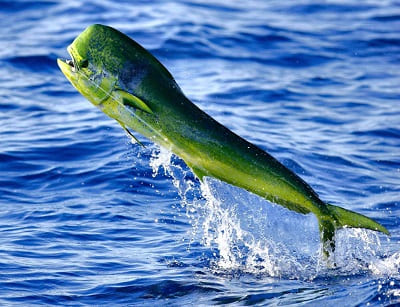Home › Sea Life Species › Marine Animals › Vertebrates › Dolphinfish
Facts about the Common Dolphin Fish
[Phylum: Chordata] [Class: Actinopterygii (bony-fish)] [Order: Carangiformes] [Family: Coryphaenidae]
Despite being called a dolphin fish, the mahi mahi is a predatory marine fish that spends most of its time near the surface of temperate, tropical, and subtropical waters.
This section contains fun facts and comprehensive information about the mahi-mahi, a blunt faced, ray-finned, fish species with shimmering colours of blue and gold.
Mahi Mahi Appearance and Characteristics
As a matter of fact, mahi-mahi fish are not related in any way, shape, or form to the dolphin (dolphins are mammals).
Instead, its confusing alias comes from the fact that mahi mahi's tend to swim fast like dolphins - ahead of sailing vessels.
Dolphinfish can reach swim speeds up to 50 knots (60 mph) because of their flattened slender body and sharp, extended dorsal fin.
The forehead in adult male species is large and it protrudes high above its body. But, the temple is more bulbous and rounded in females.
Other striking features include their concave caudal and anal fins, with varying amounts of body colouring. Mahi mahi have gold, blue, and green sides with shining blue pectoral fins.
Marine biologists think their vivid colours help them to avoid detection from their natural predators, which includes birds, marlins, certain species of sharks, and swordfish.
As they roam the open oceans, common dolphinfish create a kind of camouflage as strong sunlight reflects off the glistening skin, resulting in a change of appearance and size.
How Big is an Average Mahi Mahi?
Even though the females do not grow as big as the males, mahi mahi can reach overall lengths around one metre (40 inches) and weigh up to thirteen kilograms (30 pounds).
Dolphinfish Habitat and Distribution
You can find mahi-mahi in the saltwater oceans around Hawaii (the Pacific), the Gulf of Mexico, the Atlantic Ocean, and parts of the Indian Ocean.
It is a surface-dwelling, migratory fish species that often leads a solitary life or they sometimes band together in a large group (up to fifty) to create extra protection against their predators.
They spawn in open seas and then travel to coastal regions when the water temperature rises. Their populations in the Atlantic and Pacific are thought to be stable and the IUCN ranks common dolphinfish as being of 'Least Concern' (LC).
 What Do Mahi Mahi Fish Eat?
What Do Mahi Mahi Fish Eat?
Even though their regular diet is a varied one, their favourite food will include:
- Crab species
- Crustaceans
- Cuttlefishes
- Flying fish
- Mackerel
- Pelagic larvae
- Sargassum seaweed
- Squid
- Zooplankton
Note: The Mahi Mahi (common dolphinfish) is a big threat to the survival of juvenile cobia fish species, primarily because the larvae float in the water column after hatching.
Mahi-Mahi Fish Behaviour and Reproduction
Like most fish families, they communicate with one another through a combination of chemicals and their sensory organs (e.g. smell and touch).
It takes less than five months for the males and females to become sexually mature and start multiplying. This is why many aficionados consider them as being 'the rabbits of the ocean'.
When females spawn, they can release up to one million eggs each time, and they can repeat this activity several times per year.
Over the generations, the mahi mahi fish have become a fast growing species. This important adaptation has also increased the survival rates of their population because a typical lifespan for the dolphinfish is a maximum of five years.
Interesting Facts about Dolphinfish
The following information enhances the mahi-mahi fish species facts guide with short snippets of unfamiliar data and educational research.
- The species is widespread in Hawaii and the name mahi-mahi translates to 'very strong' in Polynesian language.
- Besides escaping its predators, they move very fast in the water because they get oxygen by pushing water through their gills.
- The scientific name for the common dolphin fish is Coryphaena hippurus and its closest relatives are the cobia, jack, and the remora (suckerfish).
- Being a cold-blooded marine fish, they are susceptible to cold water temperatures. In fact, up to 30% of young mahi mahi die prematurely because of the harsh environment or from starvation.
- Depending on the region, there are several different names used to describe this fish species, for example:
- Capone (Italian)
- Coryphene (French)
- Dorado or Llampuga (Spanish)
- Goldmakrele (German)
- Shiira (Japanese)
- Some people will pay a high price for its meat. So much so that fishing for mahi-mahi is an important industry in some parts of the world - especially the United States.
Related Information and Help Guides
- Bull Sharks Facts and Information with Pictures
- Grouper Fish Species Description and Characteristics
- Is it Bad for Scuba Divers to Feed Fishes?
- List of Marine Vertebrates Examples for Beginners
- Where is a Good Dive Site to See Cobia Fish Species?
Note: Like most plants and animals in the sea, the mahi mahi fish will try to defend itself if something (or someone) is provoking or threatening it. In general, they will not harm scuba divers. But, they will thrash around with dangerous tail motions during a catch (e.g. when deep sea fishing in Thailand).